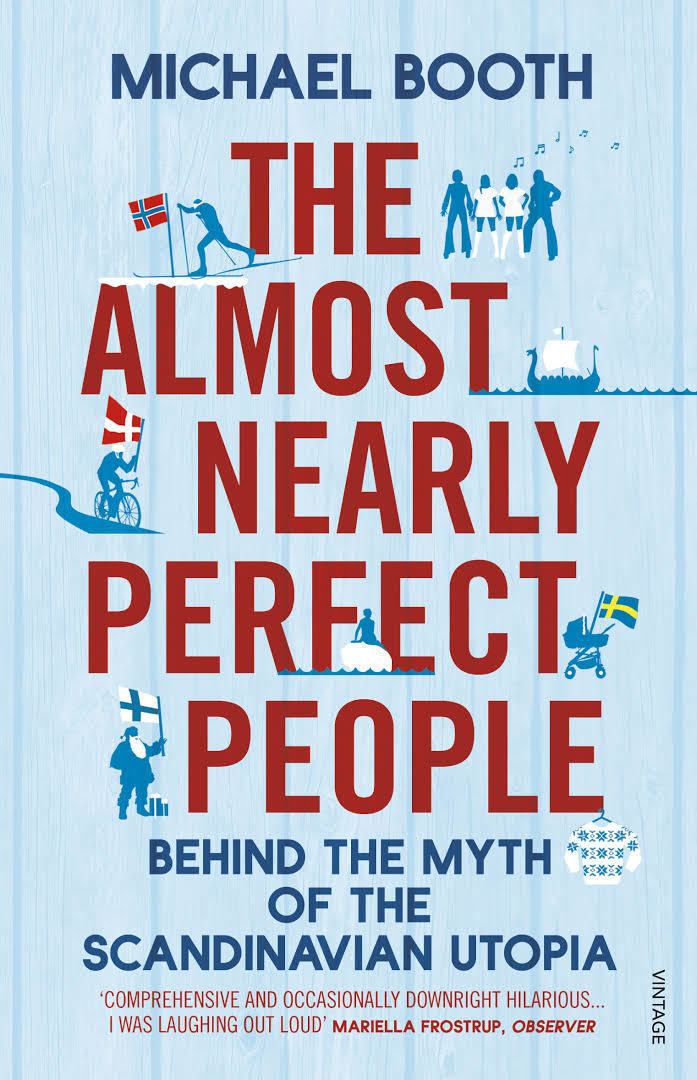8 /10 1 Votes8
4/5 The Telegraph Language English Originally published 2014 Country United Kingdom Page count 416 | 3.9/5 Goodreads 4/5 Barnes & Noble Pages 416 Genre Non-fiction ISBN 9780224089623 | |||||||||||||||||||||||||||||||||
 | ||||||||||||||||||||||||||||||||||
Similar Scandinavia books, Non-fiction books | ||||||||||||||||||||||||||||||||||
The Almost Nearly Perfect People: The Truth About the Nordic Miracle is a 2014 nonfiction book by the British journalist Michael Booth. In the book, Booth focuses on the five Nordic countries—Denmark, Iceland, Norway, Finland and Sweden—dedicating a section of the book to each one. He began writing the book after migrating from England to Denmark, based on his perceptions of the Nordic region before and after moving. He wanted to present an alternative perspective to the extremely positive depiction of the region in British media. The book received mixed reviews: some critics found it to be overly critical with poor humour, others praised its tone and informativeness.
Contents
Background and release
Michael Booth began writing The Almost Nearly Perfect People when he moved from England to Denmark about 15 years before its publication in 2014. Before moving, he had perceived Scandinavians to be a "bearded, woolly jumper-wearing, recycling bunch of people", but afterwards was surprised by how different each of the Nordic countries seemed to be. He wanted to write a book to explore these differences and to explain what he saw as a "fascinating dysfunctional family dynamic" between the five Nordic neighbors. He was further inspired by the "Nordic wave" phenomenon that gained popularity in the 2000s and 2010s when the western world became fascinated with the Nordic countries and their ways of life. In particular, he wanted to investigate Denmark's consistently high scores on various happiness indexes, since these figures conflicted with his own observations that "they didn't seem that happy", and also challenge the perception that the Nordic nations as a group are "little jolly green countries in the north".
Booth undertook four years of research while writing the book, including travelling to each of the countries and interviewing prominent political and cultural figures of each nationality. In writing about each country, he tried to examine both their successes and their weaknesses to "rebalance the utopian view" of Scandinavia held by many British people and to present a different perspective of the region than the extremely positive depiction in a lot of British media. The tone of the book was inspired by Simon Winder's Germania, which combines humour with an historical and travel-based narrative.
The book was published in English on 14 February 2014 by Jonathan Cape. Its first publication, however, was in September 2013 as a Danish translation. Although the manuscript was in English, it was translated and published first in Denmark. On 23 October 2014, the book was translated into Finnish. The Polish translation came on 7 October 2015. In addition, a Norwegian translation of the book is planned.
Content
The Almost Nearly Perfect People is divided into five sections for Denmark, Iceland, Norway, Finland and Sweden. Beginning with Denmark, Booth explains the Danish concept of hygge ("cosy times"), which he sees as conformism. He criticises the Danish population's environmental footprint and notes that their taxation rate and levels of personal debt are among the highest in the world. Moving to Iceland, Booth details the banking practices that led to the collapse of the country's largest banks in the 2008 financial crisis, as well as the popular belief among Icelanders in the existence of Huldufólk (elves).
In Norway, he highlights the rise of far-right politics, the widespread opposition to immigration, and the multiple high-profile Norwegian neo-Nazis. He notes that despite having a "nature-loving" reputation, Norway has a large ecological footprint, and that the sale of fossil fuels accounts for much of the country's wealth. He recounts Finland's history of heavy alcohol consumption and its high rates of murder, suicide, and antipsychotic drug use. He explains the Finnish concept of sisu and what he sees as the resulting obsession with machismo.
Sweden receives Booth's strongest criticism, where consumerist influences are blamed for the apparent downfall of the Nordic model of social democracy and recurrent failures of the Swedish justice system. He argues that Sweden, with its strict rules of social etiquette, has a strong culture of conformity.
Denmark
Iceland
Norway
Finland
Sweden
Reception
The Almost Nearly Perfect People received mixed reviews from critics:
